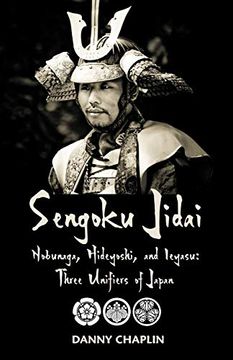Compartir
Sengoku Jidai. Nobunaga, Hideyoshi, and Ieyasu: Three Unifiers of Japan (en Inglés)
Danny Chaplin
(Autor)
·
Createspace Independent Publishing Platform
· Tapa Blanda
Sengoku Jidai. Nobunaga, Hideyoshi, and Ieyasu: Three Unifiers of Japan (en Inglés) - Chaplin, Danny
S/ 176,63
S/ 353,27
Ahorras: S/ 176,63
Elige la lista en la que quieres agregar tu producto o crea una nueva lista
✓ Producto agregado correctamente a la lista de deseos.
Ir a Mis Listas
Origen: Estados Unidos
(Costos de importación incluídos en el precio)
Se enviará desde nuestra bodega entre el
Martes 02 de Julio y el
Martes 16 de Julio.
Lo recibirás en cualquier lugar de Perú entre 2 y 5 días hábiles luego del envío.
Reseña del libro "Sengoku Jidai. Nobunaga, Hideyoshi, and Ieyasu: Three Unifiers of Japan (en Inglés)"
Japan's Sengoku jidai ('Warring States Period') was a time of crisis and upheaval, a chaotic epoch when the relatively low-born rural military class of 'bushi' (samurai warriors) succeeded in overthrowing their social superiors in the court throughout much of the country. Into this tumultuous age of constant warfare came three remarkable individuals: Oda Nobunaga (1534-1582), Toyotomi Hideyoshi (1537-1598), and Tokugawa Ieyasu (1543-1616). Each would play a unique role in the re-unification of the disparate, fragmented collection of warring provinces which constituted Japan in the sixteenth and early seventeenth-centuries. This new narrative history of the sengoku era draws together the epic strands of their three stories for the first time. It offers a coherent survey of the Azuchi-Momoyama Period (1568-1600) under both Nobunaga and Hideyoshi, followed by the founding years of the Tokugawa shogunate (1600-1616). Every pivotal battle fought by each of these three hegemons is explored in depth from Okehazama (1560) and Nagashino (1575) to Sekigahara (1600) and the Two Sieges of Osaka Castle (1614-15). In addition, the political and administrative underpinnings of their rule is also examined, as well as the marginal role played by western foreigners ('nanban') and the Christian religion in early modern Japanese society. In its scope, the story of Japan's three unifiers ('the Fool', 'the Monkey', and 'the Old Badger') is a sweeping saga encompassing acts of unimaginable cruelty as well as feats of great samurai heroism which were venerated and written about long into the peaceful Edo/Tokugawa period.
- 0% (0)
- 0% (0)
- 0% (0)
- 0% (0)
- 0% (0)
Todos los libros de nuestro catálogo son Originales.
El libro está escrito en Inglés.
La encuadernación de esta edición es Tapa Blanda.
✓ Producto agregado correctamente al carro, Ir a Pagar.

